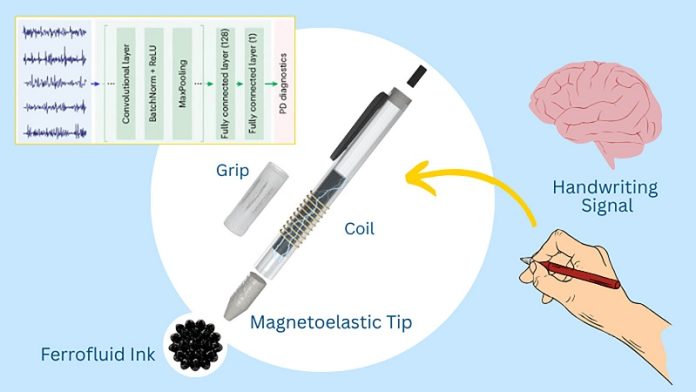
Catching Parkinson’s disease early is one of the biggest challenges doctors face.
Many people with the condition aren’t diagnosed until it’s already done serious damage to their brain.
By the time symptoms like shaking hands or stiff muscles appear, over half of the brain’s dopamine-producing neurons may already be gone.
At that point, treatment options are limited, and the disease has often progressed too far for early interventions to work effectively.
Current medical tests for detecting Parkinson’s can look for signs such as cell loss in the brain or changes in blood.
But these tests often require expensive equipment and must be done at large hospitals or research centers. This makes early detection hard to access, especially for people living in rural or underserved areas.
Now, a team of researchers led by Jun Chen, a bioengineering professor at UCLA, has created an easy-to-use and surprisingly simple device that could help change that.
The tool looks like a regular pen—but it’s a smart, 3D-printed pen powered by movement and magnetism. It’s designed to spot early signs of Parkinson’s just by analyzing how a person writes.
The pen has a soft silicon tip and uses ferrofluid ink, which contains tiny magnetic particles. When someone moves the pen across a surface or even waves it through the air, the tip’s magnetic properties change slightly.
These changes are picked up by a coil of special yarn wrapped around the pen, which captures detailed motion signals. The pen doesn’t require batteries or plugs—it generates power from the motion itself.
To see if the pen could actually help diagnose Parkinson’s, the researchers tested it in a small study with 16 people, including three diagnosed with the disease.
Participants were asked to write with the pen, and the signals were fed into an AI system trained to detect handwriting patterns linked to Parkinson’s. The system successfully identified who had the disease with an average accuracy of over 96%.
According to Chen, this pen could make it easier to spot early warning signs of Parkinson’s that might otherwise go unnoticed. Subtle motor changes are often missed during routine check-ups because they’re too mild to see without specialized tools. But this pen can pick up on those tiny movements and turn them into useful data.
In the future, doctors might be able to give a simple handwriting test during regular check-ups using this pen.
It could help catch Parkinson’s early—when treatment has the best chance of slowing the disease’s progress. The research team also believes this approach could be adapted to help detect other neurological conditions in a low-cost, accessible way.



